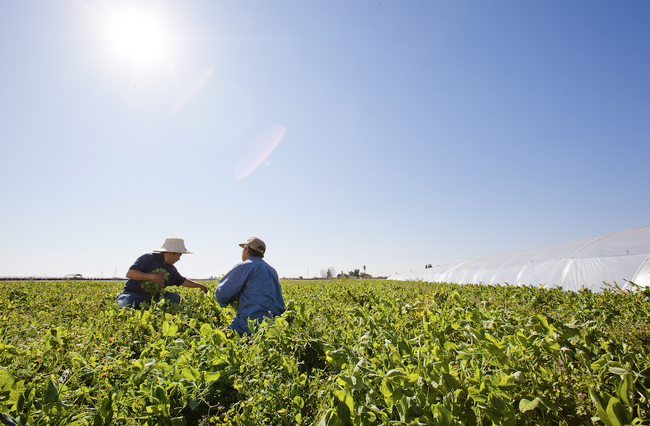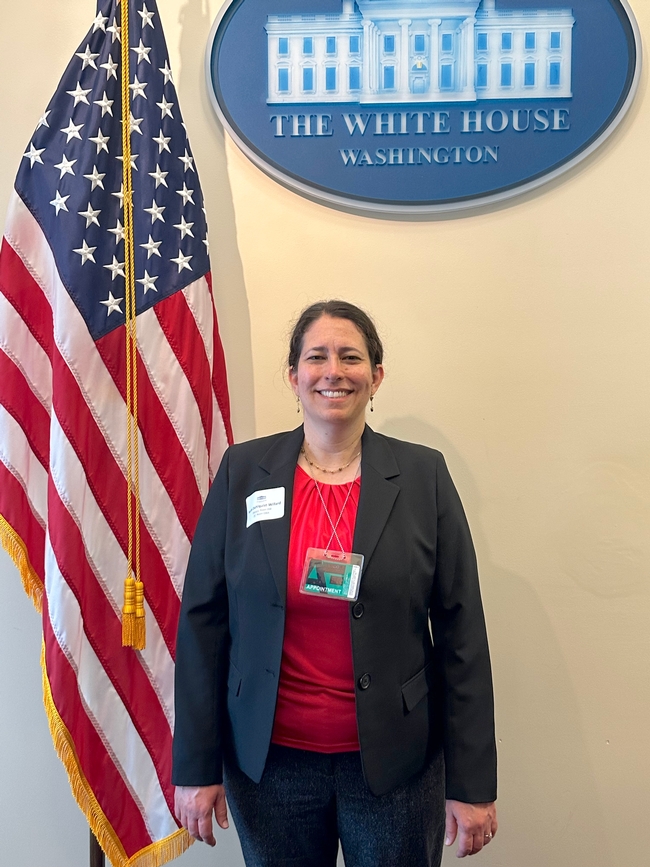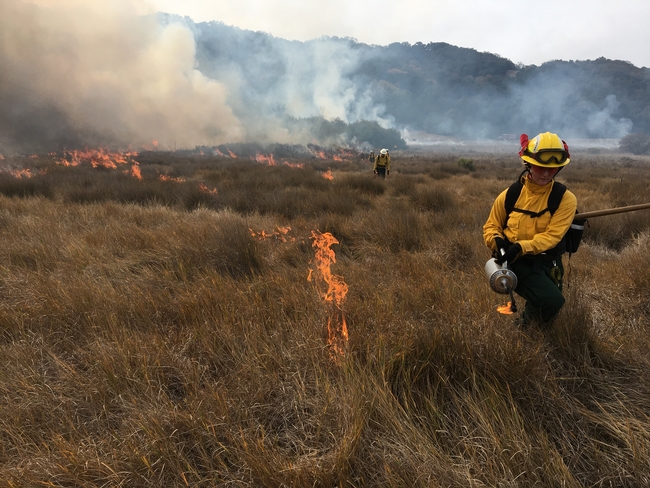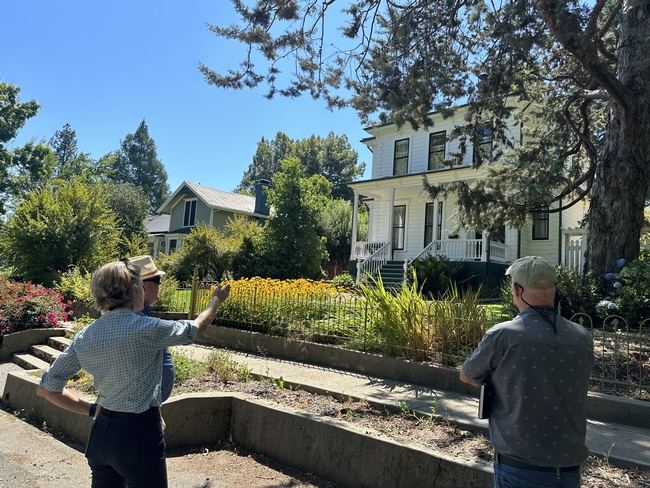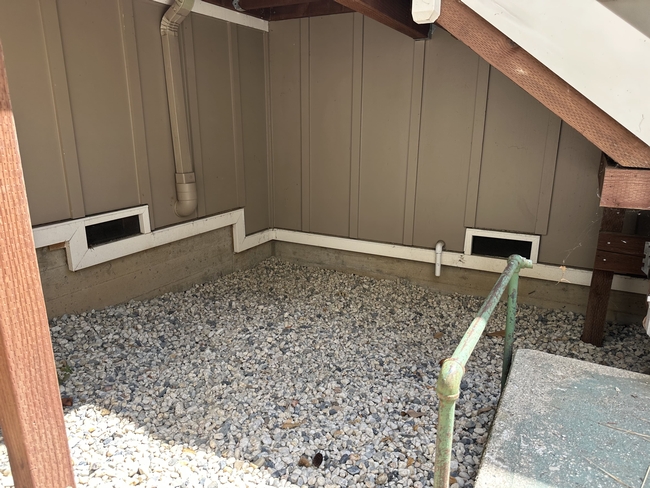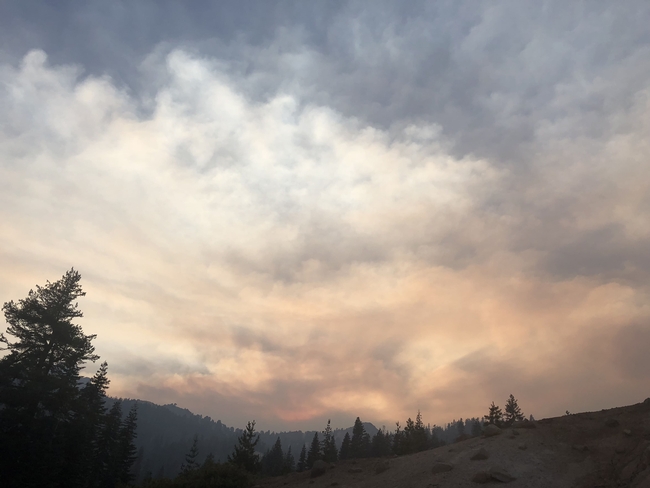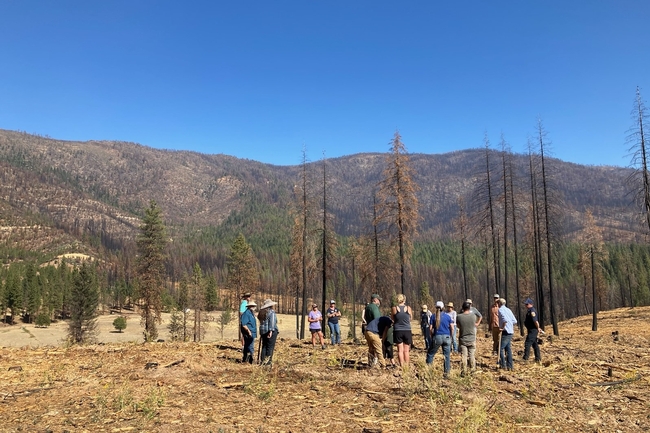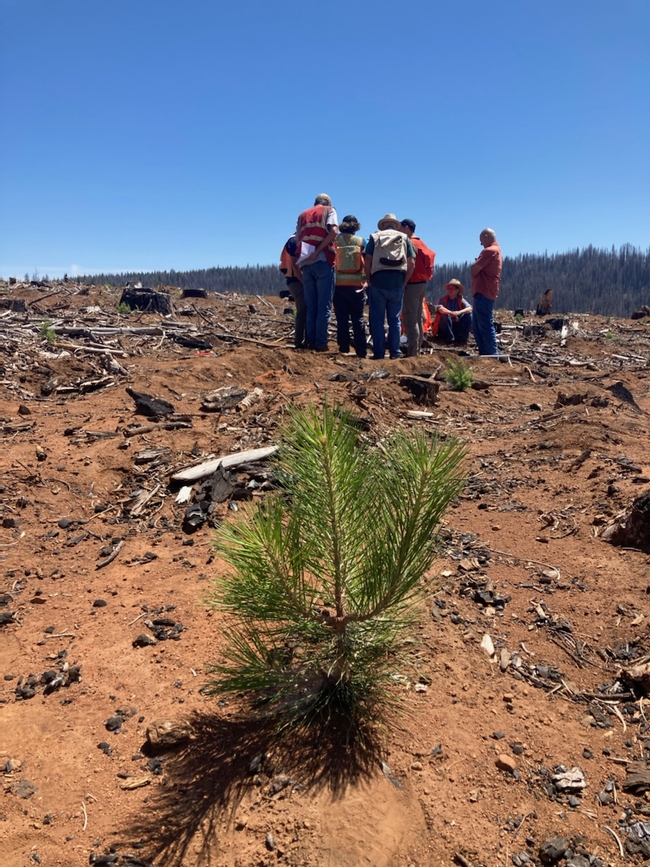Posts Tagged: environment
White House Summit explores impact of extreme heat, ways to adapt
UC ANR Small Farms Network supports small-scale and underserved farmers impacted by extreme heat
Ruth Dahlquist-Willard, interim director for the UC Sustainable Agriculture Research and Education Program, joined more than 100 participants from across the country at the first-ever White House Summit on Extreme Heat. Community representatives and practitioners met with federal agency representatives and Biden Administration officials to discuss successful locally tailored, community-driven practices to adapt to extreme heat as well as available federal resources.
According to the National Oceanic and Atmospheric Administration or NOAA, summer 2024 was California's warmest summer on record. As California's climate is changing, episodes of extreme heat are becoming more common, leading to substantial health, economic and ecosystem impacts.
In the agricultural sector, extreme heat events can cause heat illness in farmworkers, crop losses and changes in pest pressure. California crop losses due to drought, wildfire and heat were estimated at $239 million in 2023.
Disaster relief funds are available to help growers recover from lost production due to extreme heat. Since 2021, the UC ANR Small Farms Network has connected small-scale farmers with over $5.8 million in direct-to-producer relief funds for losses related to drought, flooding and other extreme weather events.
To further support small-scale farmers in adapting to the changing climate, Dahlquist-Willard and the Small Farms Network are evaluating how the extreme heat of summer 2024 impacted farmers. Farmers reported anecdotal observations that included:
- Shifting work hours to cooler parts of the day
- Closing farm stands and farmers markets due to extreme heat
- Crops ripening more quickly than expected, impacting harvesting and packing schedules
- Poor fruit set due to extremely high temperatures
The team is working to determine what damage symptoms on small-acreage California specialty crops can be attributed to extreme heat based on scientific literature and assessments from UC ANR colleagues. Understanding the impact of extreme heat on the farming community can help inform research and policy, ultimately equipping farmers with strategies to adapt to extreme heat events.
“It was inspiring to meet with leaders from around the nation who are working to support communities impacted by extreme heat and learn about the creative solutions they are implementing,” said Dahlquist-Willard. “The challenges faced by these communities make it all the more important to continue to work against climate change by reducing greenhouse gas emissions, as well as to develop new methods and resources to mitigate the effects of extreme heat and other climate impacts.”
The Extreme Heat Summit highlighted the Biden-Harris Administration's investments in climate reliance and put forth an Extreme Heat Call to Action calling upon public and private sectors to prepare for future extreme heat events. Communities and governments interested in participating are asked to use all available tools to protect people from extreme heat. Approaches and tools which could be used to protect people and resources from extreme heat are highlighted in the U.S. Climate Resilience Toolkit and the National Heat Strategy. Submissions for the Call to Action will be accepted through Nov. 1, 2024.
Further reading:
Heat Illness Prevention, UC Davis Western Center for Agricultural Health and Safety
Pathak et al., 2018. Climate Change Trends and Impacts on California Agriculture: A Detailed Review
UC's New Climate Action Goals: Frequently Asked Questions
Hands-on learning, training make irrigation best practices accessible
UCCE advisors provide free training to nursery and greenhouse staff
Working as an irrigator seems straightforward at first: if you're not watering plants by hand, you're building and managing systems that can do the watering. What could be complex about a job like this?
University of California Cooperative Extension advisors Bruno Pitton and Gerardo “Gerry” Spinelli can tell you – or better yet, show you.
Pitton and Spinelli, members of the UC Nursery and Floriculture Alliance, offer a one-day technical training in irrigation best-management practices for irrigators working with containerized nursery plants. The comprehensive curriculum – developed with input from two focus groups of California nursery and greenhouse managers – aims to improve irrigation efficiency, reduce water consumption and improve plant health.
Thanks to funding from the California Department of Food and Agriculture, nursery and greenhouse managers in California can request this training for free and advisors like Pitton and Spinelli will travel to conduct the training on-site.
The complexities of irrigation incorporate concepts like evapotranspiration, salinity, irrigation uniformity, capillarity, pressure and flow rate. Spinelli, UCCE production horticulture advisor for San Diego County, said that irrigators have a critical role in the industry because of all the things they must consider to do their job well.
“Our goal is to support irrigators and help them become more confident decision-makers and experts in the field,” said Pitton, UCCE environmental horticulture advisor for Placer and Nevada counties.
Interactive sessions reveal nuances of irrigation
The training consists of a presentation on fundamental concepts for managing irrigation in container plant production and hands-on demonstrations. “In the nursery industry, where precise irrigation is crucial for the health and productivity of our crops, having access to expert knowledge is invaluable,” said Mauricio de Almeida, general manager of Burchell Nursery in Fresno County. “The training's practical demonstrations and real-world examples made the concepts easy to grasp, allowing our team to implement the strategies immediately.”
For one of the demonstrations, the advisors used sponges to model soil saturation when water is applied. Ana, an irrigator at Burchell Nursery, appreciated the step-by-step explanations, which helped her better understand how water pressure differs in drip irrigation, sprinklers and watering by hand. Doing this out in the field, as an example of how irrigation audits occur, was extremely helpful for attendees.
Francisco “Frank” Anguiano, production manager of Boething Treeland Farms in Ventura County, observed his team of irrigators as they learned how to measure distribution uniformity with water collected from sprinklers. “This training isn't just about irrigation and plant management. It's also about savings, both water and costs. Who doesn't want to save money and use less water?” Anguiano said.
Reducing the barriers to learning
Many of the irrigators attending these trainings gained their skills and knowledge from life experience rather than a college education, explained Peter van Horenbeeck, vice president of Boething Treeland Farms. “It's important that my irrigators learn from external experts, but it's more important that they can relate to them. And that's what Gerry was able to do,” van Horenbeeck added.
Regarding content and delivery, and referencing what he learned from the focus groups, Pitton wanted the trainings to be easy to understand and engaging. For example, scientists use the term “matric potential” to describe how soil particles hold water against gravity, which is the same as capillary rise. “We demonstrate this concept with a paper towel held vertically and dipped into a beaker of dyed water that it absorbs,” said Pitton.
Many of the irrigators in attendance agreed that hands-on activities and visual aids were instrumental to their learning. Charli, another irrigator at Burchell Nursery, shared that the in-field examples and hosting the training in Spanish kept them engaged.To address language barriers, Spinelli has been conducting trainings in Spanish – a common request from many nurseries with eager participants.
Maintaining state regulations and partnerships
Although the technical aspects of irrigation management are key elements of the training, regulatory compliance is also addressed. Recognizing the finite availability of water and the environmental impact of pollution, the advisors highlight irrigation and fertilizer management and runoff prevention as critical components of compliance.
Under Ag Order 4.0 administered by California's Water Resources Control Board, growers must comply with stricter policies regulating nitrogen use. As irrigators learn from the training, better control of irrigation can certainly make a difference.
Deanna van Klaveren, chief operating officer and co-owner of Generation Growers in Stanislaus County, said the most valuable aspect of the training was learning on-site and completing an audit on her own systems. “It is so much more impactful to have trainings like this on-site where our staff can learn and then go out into the nursery and actually put it into practice while the presenters/experts are there,” van Klaveren said.
Pitton and Spinelli described the partnership between UC Cooperative Extension and CDFA as “symbiotic” given the technical and educational capacity of UCCE advisors who conduct research and extension.
“It's a great example of how the two institutions can collaborate successfully. Californians are the ones who win because they get a service for free,” added Spinelli. “And it's rewarding for us to see so much interest in what we, as advisors, do.”
If you are a nursery or greenhouse operator and would like to request the Irrigation Best Management Practices training, please contact the UCCE advisor assigned to the region that corresponds with your nursery location below.
Northern California
- Jessie Godfrey, UCCE environmental horticulture and water resources management advisor, jmgodfrey@ucanr.edu
Central Coast (Santa Cruz County to Ventura County)
- Emma Volk, UCCE production horticulture advisor, evolk@ucanr.edu
San Joaquin Valley
- Chris Shogren, UCCE environmental horticulture advisor, cjshogren@ucanr.edu
Southern California
- Grant Johnson, UCCE urban agriculture technology advisor, gejohnson@ucanr.edu
Spanish Trainings Only
- Gerry Spinelli, UCCE production horticulture advisor, gspinelli@ucanr.edu
Public invited to see ‘good fire’ Oct. 5 at Central Coast fair
Learn the how, where and why fire is used to manage the natural landscape at the Central Coast Good Fire Fair on Saturday, Oct. 5. The fair is free and open to the public from 10 a.m. to 3 p.m. at Henry Cowell Redwoods State Park in Felton in Santa Cruz County. The event is sponsored by the UC Agriculture and Natural Resources Fire Network and California State Parks.
“You can witness a live prescribed fire in the redwood grove and learn about using fire in our coastal ecosystems,” said Barb Satink Wolfson, UC Cooperative Extension fire advisor for San Benito, Santa Clara, Monterey and Santa Cruz counties.
Representatives of California State Parks, CALFIRE, indigenous groups and the Central Coast Prescribed Burn Association are scheduled to talk about how they work with fire.
The Good Fire Fair will offer educational activities for children and adults:
- Learn how to safely build, tend and extinguish a campfire
- Watch live burns of piles and redwood understory growth (likely between 11 a.m. and 1 p.m., depending on the weather)
- Savor sandwiches, burgers and Venezuelan food from local food trucks
- Observe demonstrations and visit informative booths
- Learn how to make your home more resilient to wildfire
- Test your fire knowledge and win prizes
“Kids will get to see a wildland fire engine up close, try fire science experiments and play educational games. Bring a camera,” said Satink Wolfson. “Knowledge feeds the soul, but two of Santa Cruz's best food trucks will feed your hunger!”
The event is free, but parking at the park is $10. No registration required.
Simple tasks make big difference in preparing for wildfire, smoke
UC ANR Fire Network compiles expert advice on preparedness, evacuation tasks
The explosive growth of the Park Fire in Northern California was fueled by recent, intense heat waves and extremely dry vegetation – conditions seen at many locations across the state.
Given the potential for wildfire and smoke impacts during what is expected to be a protracted “fire season,” California residents should think ahead and complete emergency preparations: https://ucanr.edu/sites/fire/Preparedness/.
“If you are concerned that you or someone you know could be affected by fire or smoke, now is the time to take simple steps to prepare,” said Yana Valachovic, University of California Cooperative Extension forest advisor for Humboldt and Del Norte counties.
Valachovic and other members of the UC Agriculture and Natural Resources Fire Network are urging community members to tackle small but significant tasks to minimize potential fire damage. Many of these tasks can be finished in a weekend, such as:
- Clean debris from your roof and gutters.
- Inspect the area around your home and nearby structures and remove all combustibles (dead grass, plants, woody mulch, stored wood, etc.) in the first 5 feet, including under decks and stairs.
- Inspect the foundation, under-eave, and gable-end vents for holes and damage; add a layer of finer metal-mesh screens (1/8” mesh) to the vents to prevent ember penetration.
- Inspect the garage door bottom seal to make sure embers can't blow under the door.
- Replace the first 5 feet of wooden fences that attach to buildings with a noncombustible panel or gate.
A recently published report, “Retrofitting a Home for Wildfire Resistance,” also can help residents prioritize the measures that are most cost-effective and fit their budget.
Six things to do, six hours before evacuation
As evacuation warnings are issued for local communities, there are six important things to do in advance of an actual evacuation order, according to Valachovic:
- Close windows, pet doors and skylights.
- Move inside patio cushions, brooms and door mats; tie open wooden gates that attach to the house or deck to prevent a fire from traveling from the fence to the house.
- Relocate the barbecue propane tank away from home.
- Stage buckets of water and garden hoses in visible locations.
- Dress for evacuation: cotton clothes, sturdy shoes, hat and face protection and leather gloves.
- Put your “go bag” in your vehicle.
The UC ANR Fire Network website also includes downloadable checklists – in English and Spanish – for your go bag (https://ucanr.edu/sites/fire/Safety/Evacuation/Preparing_a_Go-Bag/) and for a host of important pre-evacuation tasks for your household, property, pets and livestock (https://ucanr.edu/sites/fire/Safety/Evacuation/).
“We want communities to be wildfire-prepared – not scared,” Valachovic emphasized.
Smoke exposure a significant public health concern
Hazardous smoke can blanket wide swaths of California – and much of the Western U.S. – during ongoing wildfire events. A primer on harmful health effects, a list of tips for reducing smoke exposure, and other resources and links can be found on the UC ANR Fire Network site: https://ucanr.edu/sites/fire/Safety/Air_Quality_and_Smoke/.
“If there's smoke in the forecast for the next few days, I would keep an eye on my local air quality at fire.airnow.gov,” said Katie Low, statewide coordinator for UC ANR's Fire Network. “And if the AQI – Air Quality Index – is high, I would limit my outdoor activity, wear an N95 mask if I do go outside, and run my air purifier.”
For instructions on making a DIY air cleaner, creating a “clean air space” in your home and fitting an N95 mask properly, visit the California Air Resources Board's “Smoke Ready California” page: https://ww2.arb.ca.gov/smokereadyca.
Another useful tool is the crowd-sourced #FireMappers fire activity map – powered by the National Alliance for Public Safety GIS Foundation, GISCorps, and CEDR Digital Corps – accessible through the UC ANR Fire Network site: https://ucanr.edu/sites/fire/Safety/Current/.
UCCE report: Local forest restoration teams effective at rapid response
Quickly planting trees after wildfires crucial for communities, ecosystems, carbon goals
As the climate crisis fuels more high-severity wildfires, many forests – adapted to bounce back from frequent but less-intense fires – are struggling to recover quickly.
“In a lot of locations, forests in the Sierra Nevada that burn at high severity are not regenerating on their own,” said Susie Kocher, University of California Cooperative Extension forestry and natural resources advisor for the Central Sierra. “They need to have living trees to drop seeds; if everything dies in an intense fire, then there's a high likelihood in those locations that trees might not return for a while.”
According to Kocher, a forest may take multiple decades to grow back on its own, seeding in very slowly from the edges of a burn. To speed up that regeneration process, a pilot program of local “Emergency Forest Restoration Teams,” or EFRTs, have been helping forest landowners rapidly remove dead trees, plant new seedlings and expedite other vital tasks after wildfires.
Kocher is a co-author of a recently released report evaluating the EFRTs, which appear to be effective in assisting often-overwhelmed private landowners navigate competitive funding programs and complicated permitting pathways after wildfire. Small private landowners in California own 7 million acres, comprising 22% of forested land across the state.
“None of our current assistance programs were really designed to rapidly respond to high-severity fire disasters,” Kocher said. “And we're just getting so much more high-severity fire now that there needed to be a different way of helping people, besides business as usual.”
Lead agencies improve coordination of restoration efforts
Drawing from a successful model in Washington, Kocher and other members of the Governor's Forest Management Task Force recommended the formation of EFRTs in 2019 and this recommendation made it into the California Wildfire and Forest Resilience Action Plan of 2021.
Following the Caldor, Dixie and Tamarack fires during that year, disaster relief funds from CAL FIRE and the U.S. Forest Service enabled the establishment of pilot EFRTs in each of the affected regions. A key innovation was designating a local lead agency to coordinate restoration efforts: the El Dorado Resource Conservation District (Caldor), the Feather River Resource Conservation District (Dixie) and Alpine County (Tamarack).
“The idea is that one well-established local agency gets the funds to carry out all the reforestation work,” Kocher said. “They find contractors for the landowners and plan and carry out all the work needed, including dead tree removal, site preparation and replanting; this helps it be more coordinated across the landscape and reduces competition for contractors.”
“Also, for most of that work, there's no cost to the landowner – which is a huge benefit to them, because these things can get really expensive, like many thousands of dollars an acre,” Kocher added.
Although there was an initial steep learning curve for the local lead agencies on the complexities of reforestation and the maze of required permits, they quickly executed a significant number of forest restoration treatments. Within two years, the three pilot teams had collectively completed over 2,500 acres of dead tree removal and 1,400 acres of conifer planting.
“The overwhelming benefit of the pilots was that a lot of work got done on the ground, that otherwise would not have been done – at least not in the timeframe that was made possible by the EFRTs,” said Daylin Wade, a UCCE staff research associate and co-author of the recent report, who synthesized feedback from interviews of professionals involved in the program.
Rapid reforestation better financially, ecologically
Both Wade and Kocher underscored how the EFRTs were crucial in completing restoration tasks in a timely manner. Removal of dead wood becomes trickier and more expensive over time, as the trees decay and are dangerous to cut down.
“A major accomplishment was getting trees out of there while it was both safe and economically viable to remove those trees – and getting trees in the ground before shrubs dominate the site,” Wade explained.
It's also imperative to quickly remove the dead trees to reduce the fuel load and minimize the chances of re-burn in the area.
“If you're not doing this work, then you're actually endangering the investment that you're putting into rebuilding communities that burned, because they're in danger of burning again if you have huge piles of dead trees everywhere,” Kocher said.
Furthermore, expediting those tasks helps restore the forest cover that is crucial for sequestering carbon and achieving the goals of California's sweeping climate action plan – such as attaining carbon neutrality by 2045.
“We have very ambitious carbon goals for our forests in California, and so reestablishing them – even on private lands – is a public benefit,” Kocher said.
Evaluation of EFRTs by UC Cooperative Extension continues
In addition to enumerating the progress of the three EFRT case studies, the evaluation report also lists recommendations to further enhance the program, such as securing rapid and flexible funding for future EFRTs, improving guidance for local lead agencies and streamlining permitting processes.
The authors also stressed the need to expand opportunities for the commercial sale of woody material in the aftermath of a wildfire event. Selling logs and wood chips reduces the volume of material that would need to processed onsite by the EFRTs and their contractors, thereby defraying some of the costs for that work.
But there simply hasn't been a sufficient market for that woody biomass.
“It's a big barrier,” Kocher said. “If we had a healthier timber market, it would be easier to make this stuff pay its own way and be less of a subsidized endeavor.”
UC Cooperative Extension's EFRT evaluation work – made possible by funding from the U.S. Forest Service State, Private and Tribal Forestry, Region 5 – will continue for the next couple years. On the heels of this first report, Wade will next gather and summarize feedback from private landowners on whether the EFRTs are meeting their goals.
And, later this summer and fall, researchers will begin assessing the ecological success of the plantings in the restoration areas, surveying seedling survival and gauging the volume of competing vegetation.
“It's hugely encouraging that we've gotten all these trees in the ground, but it's not the end of the process – it's just the beginning,” Kocher said. “Trees and forests need to be maintained over time, so this next step will let us see how successful that has been, and if there are additional steps needed to actually ensure that these trees succeed and thrive.”
The full report, dedicated to the memory of report co-author and UCCE advisor Ryan Tompkins, can be found at https://ucanr.edu/efrt.

